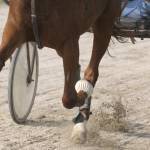Bowed Tendons in Horses: Risk Factors and Treatment Options

Injuries to tendons and ligaments are far more frequent than bone fractures among racehorses in training. An article in Trainer Magazine summarized risk factors and treatment methods for injuries to the superficial digital flexor tendon in racehorses. This tendon runs down the back of a horse’s leg from above the knee to the pastern.
Though the tendon is actually injured most often when the horse is competing in a race, cumulative damage to the fibers is a result of training. As the horse moves, fiber bundles in the tendon slide against each other, rotating like a coiled spring. Repeated loading causes microdamage to the collagen and protein that form the fibers, making the tendon more prone to injury. If the fibers tear apart, the horse will show an arched swelling, commonly known as a bowed tendon, on the back of the cannon bone.
Ultrasound images of a bowed tendon show dark areas made up of blood and inflammatory substances within the white tendon matrix. Unfortunately, two years of quarterly ultrasound examination of the tendons of 148 horses in race training was not able to predict which horses were at high risk, though almost one-quarter of these horses did have tendon injuries during the study period.
Historically, the accepted management of a horse that bowed a tendon was to turn the horse out for at least a year. This period of time allowed the tendon to heal without the stress of exercise, and a number of horses did return to some level of performance after this treatment. However, scar tissue that replaces torn tendon fibers is less elastic than the original tissue, and the new fibers may not be properly aligned to assist in the tendon’s coiled spring-like action.
More modern treatment may use stem cells harvested either from the injured horse’s own bone marrow or from the umbilical cords of newborn foals. Injected into a damaged tendon, these cells have the ability to mature into healthy tendon cells rather than scar tissue. Horses treated with stem cells will still have a lengthy recovery period before they can return to training, but the use of stem cells leads to tendon repair that is much more resistant to reinjury. Many horses can have a performance career after bowing a tendon, though they may not return to the same level of activity as before the injury.








